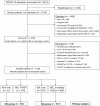Remdesivir and Mortality in Patients With Coronavirus Disease 2019
- PMID: 34409431
- PMCID: PMC9155603
- DOI: 10.1093/cid/ciab698
Remdesivir and Mortality in Patients With Coronavirus Disease 2019
Abstract
Background: The impact of remdesivir (RDV) on mortality rates in coronavirus disease 2019 (COVID-19) is controversial, and the mortality effect in subgroups of baseline disease severity has been incompletely explored. The purpose of this study was to assess the association of RDV with mortality rates in patients with COVID-19.
Methods: In this retrospective cohort study we compared persons receiving RDV with those receiving best supportive care (BSC). Patients hospitalized between 28 February and 28 May 2020 with laboratory-confirmed severe acute respiratory syndrome coronavirus 2 infection were included with the development of COVID-19 pneumonia on chest radiography and hypoxia requiring supplemental oxygen or oxygen saturation ≤94% with room air. The primary outcome was overall survival, assessed with time-dependent Cox proportional hazards regression and multivariable adjustment, including calendar time, baseline patient characteristics, corticosteroid use, and random effects for hospital.
Results: A total of 1138 patients were enrolled, including 286 who received RDV and 852 treated with BSC, 400 of whom received hydroxychloroquine. Corticosteroids were used in 20.4% of the cohort (12.6% in RDV and 23% in BSC). Comparing persons receiving RDV with those receiving BSC, the hazard ratio (95% confidence interval) for death was 0.46 (.31-.69) in the univariate model (P < .001) and 0.60 (.40-.90) in the risk-adjusted model (P = .01). In the subgroup of persons with baseline use of low-flow oxygen, the hazard ratio (95% confidence interval) for death in RDV compared with BSC was 0.63 (.39-1.00; P = .049).
Conclusion: Treatment with RDV was associated with lower mortality rates than BSC. These findings remain the same in the subgroup with baseline use of low-flow oxygen.
Keywords: COVID-19; Mortality; Remdesivir; SARS-CoV-2; Standard of Care.
© The Author(s) 2021. Published by Oxford University Press for the Infectious Diseases Society of America.
Figures



References
Publication types
MeSH terms
Substances
LinkOut - more resources
Full Text Sources
Miscellaneous

